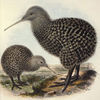Genus Apteryx

Brown Kiwi - The Southern Brown Kiwi, Tokoeka, or Common kiwi, Apteryx australis, is a species of kiwi from New Zealand's South Island. Until 2000 it was considered conspecific with the North Island Brown Kiwi, and still is by some authorities.
Great Spotted Kiwi - This kiwi is highly aggressive, and pairs will defend their large territories against other kiwi. Great Spotted Kiwi are nocturnal, and will sleep during the day in burrows. At night, they feed on invertebrates and will also eat plants. Great Spotted Kiwi breed between June and March. The egg is the largest of all birds in proportion to the size of the bird. Chicks take 75 to 85 days to hatch, and after hatching, they are abandoned by their parents.
Brown Kiwi - Until 2000, the Brown Kiwi was thought to include the Rowi and the Tokoeka, in addition to the North Island Brown Kiwi. However using genetic codes from each of the above it was determined that the Tokoeka was a separate species, it took the Apteryx australis name , leaving the Brown Kiwi with its current Apteryx mantelli name. Soon after, in 1998, more genetic tests were done with the rowi and it was determined that it was a separate species . In 2004 an injured bird was found with streaked white around the head and identified by Massey University. The white feathering is likely due to a rarely seen genetic variation sometimes described as a partial albino. Few documented cases exist with only a painting of one found in Otorohanga in the 18th century and a specimen in the Canterbury Museum. The injured bird recovered and was introduced into a breeding programme.
Little Spotted Kiwi - The Little Spotted Kiwi or Little Gray Kiwi, Apteryx owenii, is a small species of kiwi originally from New Zealand's South Island that, around 1890 and 1910 was captured and later released on Kapiti Island. Little Spotted Kiwis are the smallest species of kiwi, at about .9–1.9 kg , about the size of a bantam.



